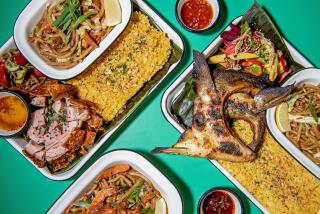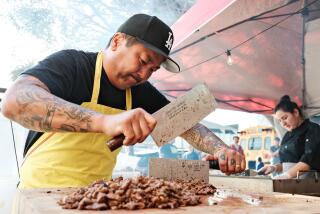Chef Gaston Acurio carves Peruvian-flavored empire
In a space that will soon house an anticucheria, or Peruvian kebab restaurant, shaggy-haired rockers flanked by buxom, jiggling Amazonian dancers in neon yellow bikinis serve up a pulsing cumbia beat to a rollicking crowd.
Surrounded by hundreds of friends and admirers flushed red by the pisco sours flowing from the bar, Gastón Acurio, the man of the hour, surveys the scene of his birthday party and smiles contentedly.
Acurio, Latin America’s premier chef, anointed by diners, fellow cooks and politicians alike, had much to be pleased about on his 41st birthday in late October. His empire of restaurant franchises recently expanded into the most coveted market of all, the United States, to satisfying critical acclaim.
In September, La Mar Cebicheria Peruana, his ceviche chain with branches in Lima, Mexico City, Madrid and beyond, opened in San Francisco at the prime location of Pier 1 1/2 on the Embarcadero -- 11,000 square feet overlooking the bay. This year, he plans to take La Mar to New York, San Diego and Los Angeles.
He is also working to bring his casual eatery-deli T’anta to Dallas. And he has two new restaurant concepts close to fruition in Lima, the anticucheria called Panchita and an upmarket juice bar called La Pepa, bringing his total number of restaurants to 27, spanning three continents.
With these developments, the twinkle-eyed Acurio has marched decisively forward as the commander-in-chief of Peru’s gastronomic revolution, a process of discovery and dissemination of native flavors that he hopes will captivate the world. “Everything in our work is inspired by putting value on Peruvian products that are undervalued,” Acurio says. “We are trying to globalize our traditions and make them global brands.”
“Acurio is the force inspiring a lot of people to improve upscale Peruvian dining options,” says Edgar Perez, founder of the Peruvian food marketing company Flavors of Peru in New York. “He was one of the first chefs to take his restaurants outside Peru and has shown that people are very receptive to Peruvian flavors.”
La Mar’s showpiece is, of course, ceviche, in its classic version a dish of raw fish cubes flash-cooked by the acid of Peruvian limes, tossed with red onion and crimson rocoto chile, and served beside large choclo corn kernels and sweet potato. La Mar offers five other versions, including a vegetarian one.
But La Mar’s menu also functions as a primer to Peru’s other seafood classics: causa, a Peruvian shepherd’s pie with layers of mashed potatoes, avocado and seafood; chupe de camarones, a hearty shrimp soup with a poached egg; and tiradito, sashimi-like slivers of sea bass bathed in bright, silky, spicy sauces.
La Mar’s pisco bar, where bartenders pour pisco sours and other cocktails spiked with the grape-based liquor, is also luring San Francisco happy-hour-goers and late-night passersby at a steady clip.
The decision to take La Mar to America ahead of his other franchises, which include the white-linen Astrid y Gastón and the fast-food Peruvian sandwich joint Hermanos Pasquale, was a conscious one.
Ceviche spotlight
Acurio suspects that Americans who know Peruvian food first think of roast chicken -- though ceviche has already gone global, thoroughly incorporated into Mexican and other Latin American cooking and found at restaurants from New American to French.
And though ceviche might be one of La Mar’s bestselling points, Acurio is convinced that once Americans get to know other Peruvian dishes, they will find a lifelong love that will keep them coming back for more.
So he has taken cues from Japanese and Mexican restaurateurs, hoping to emulate the successes of the former and avoid some of the pitfalls of the latter. Nobu Matsuhisa, the Japanese chef whose seafood restaurants (influenced by three years spent cooking in Peru) now span four continents, is also an inspiration.
“We don’t want to sell cheap food, like the Mexicans have done with tacos all over the place,” Acurio said. “The Japanese started with a very fine product -- sushi -- and that’s what we have with ceviche. We have to do the best restaurants we can, in the best cities, in the best avenues to compete with the best restaurants in the world.”
His plan also has a social element: If he can export the Peruvian food concept all over the world, then he can help build supply chains connecting small, poor Peruvian producers to the world market.
It is a lofty ambition in an age when there are dozens of enticing ethnic cuisines from around the world fighting to become the next big thing. But Acurio has already proved that his restaurants can compete with the very best in Latin America. From Santiago to Mexico City, they are regularly full. And he has impressed investors with his revenue, projected to hit $120 million this year.
Many hats
In Peru, Acurio has taken the term “celebrity chef” to new levels. Beyond the requisite television show, the cookbooks, the flashy restaurant openings and the perpetual media attention, he designs elaborate meals for President Alan Garcia to promote the under-appreciated Peruvian anchovy, has serious tête-à-têtes with international potato scientists in the Andes about undiscovered potato varieties, and roams Lima’s streets sampling the best of the city’s cartilleros, or street cart vendors, and inviting them to his food fairs.
Although he initially planned to be a lawyer and was sent to France by his well-heeled family to earn a degree, he quickly left to study cooking at Le Cordon Bleu in Paris, where he met his pastry-chef wife, Astrid Gutsche. When they returned to Lima in 1994, they opened Astrid y Gastón as a French restaurant.
With time, he became a master of his country’s native foods -- black clams, potatoes, quinoa, aji peppers, to name a few. By 1999, the restaurant was Peruvian, showcasing his flair for teasing out the ingredients’ best attributes and reassembling them in traditional and avant-garde ways. From there, he opened La Mar, T’anta, Hermanos Pasquale and soon Panchita and La Pepa.
His success has inspired dozens of other Peruvian chefs to experiment and rediscover varieties known only to the small fishermen and the indigenous farmers in the mountains.
“We have thousands of varieties of quinoa and potatoes, and Gastón has helped create demand for many things that we weren’t really eating in Lima,” said Flavio Solorzano, the executive chef of El Señorio del Sulco, a Lima restaurant devoted to preserving traditional criollo recipes. “If he says they should try it, people follow him.”
Whether Acurio will find enough followers in the U.S. to put Peru on the map of the world’s great cuisines is not yet clear, but if La Mar’s new foothold in San Francisco is any indication, he has a shot.
More to Read
Sign up for our L.A. Times Plants newsletter
At the start of each month, get a roundup of upcoming plant-related activities and events in Southern California, along with links to tips and articles you may have missed.
You may occasionally receive promotional content from the Los Angeles Times.






